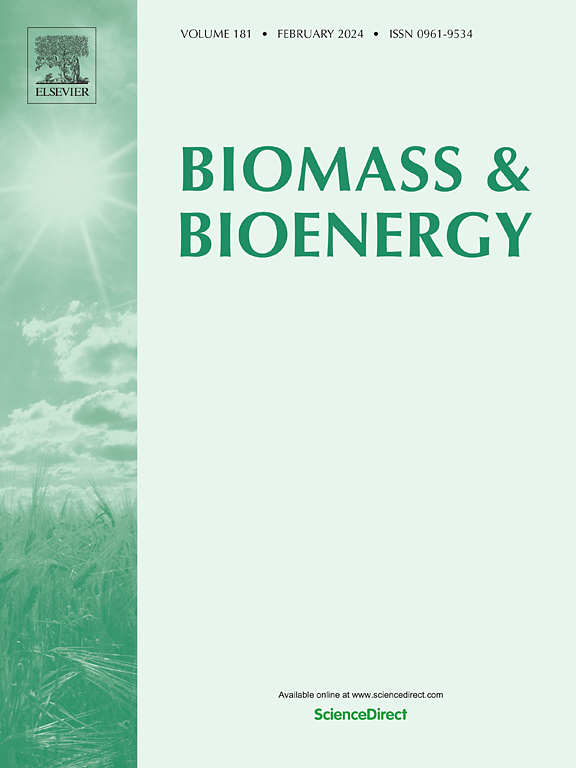Sustainable biodiesel synthesis using bamboo leaves ash doped with Anser cygnoides eggshell derived CaO (BLA@SiO2-CaO) green catalyst: Characterization and optimization study
IF 5.8
2区 生物学
Q1 AGRICULTURAL ENGINEERING
引用次数: 0
Abstract
The increasing demand for sustainable and renewable energy sources has led to significant research in biodiesel production. This study explores the synthesis of castor biodiesel using a novel bamboo leaves ash (BLA@SiO2) doped with swan goose (Anser cygnoides) eggshell derived CaO (BLA@SiO2-CaO) as green catalyst. Anser cygnoides eggshells were calcinated at 900°C for 3 h, and doped with (BLA@SiO2) via wet impregnation method at a mixing ratio of BLA@SiO2:CaO – 1:2, 1:3, and 1:4 wt%. The catalysts were characterized using X-ray diffraction, Fourier-transform infrared spectroscopy, scanning electron microscopy, and energy dispersive X-ray to determine their structural and morphological properties. Box-Behnken design-response surface methodology was employed for optimizing biodiesel production process with four input factors viz. methanol: oil molar ratio, catalyst concentration, reaction temperature and reaction time. Results indicated that BLA@SiO2-CaO catalyst exhibited excellent catalytic activity producing maximum biodiesel yield of 96.59 % under the optimal conditions of 11.49:1 methanol to oil ratio, 5.27 wt% catalyst concentration, 60.24°C reaction temperature, and 1.54 h reaction time. The properties of biodiesel, including acid value (0.48 mg KOH/g), density (0.87 g/cm3), calorific value (40.5 MJ/kg), flash point (166°C), ester content (96.9 wt%), and kinematic viscosity (4.7 mm2/s) are found to be within the ASTM-D6751 and EN 14214 standard limits. The synthesized BLA@SiO2-CaO catalyst could be reused for up to seven cycles with yield above 84.2 %. This study highlights the potential of utilizing waste materials like bamboo leaves ash and swan goose eggshells as a cost-effective and eco-friendly catalyst in biodiesel production.

竹叶灰掺杂天鹅蛋壳衍生CaO (BLA@SiO2-CaO)绿色催化剂可持续合成生物柴油:表征与优化研究
对可持续和可再生能源日益增长的需求导致了生物柴油生产的重要研究。本研究利用一种新型竹叶灰(BLA@SiO2)掺杂大雁(Anser cygnoides)蛋壳衍生的CaO (BLA@SiO2-CaO)作为绿色催化剂,探索蓖麻生物柴油的合成。在900°C下煅烧3h,以(BLA@SiO2)湿浸渍法掺杂,混合比例为BLA@SiO2:CaO - 1:2, 1:3, 1:4 wt%。采用x射线衍射、傅里叶变换红外光谱、扫描电镜和能量色散x射线对催化剂进行了表征,确定了催化剂的结构和形态性质。采用Box-Behnken设计-响应面法对甲醇:油摩尔比、催化剂浓度、反应温度和反应时间4个输入因素进行了生物柴油生产工艺优化。结果表明,BLA@SiO2-CaO催化剂在甲醇油比为11.49:1、催化剂浓度为5.27 wt%、反应温度为60.24℃、反应时间为1.54 h的条件下,具有良好的催化活性,产率为96.59±0.95%。生物柴油的性质,包括酸值(0.48 mg KOH/g),密度(0.87 g/cm3),热值(40.5 MJ/kg),闪点(166°C),酯含量(96.9 wt%)和运动粘度(4.7 mm2/s)被发现在ASTM-D6751和EN 14214标准范围内。合成的BLA@SiO2-CaO催化剂可重复使用7次,收率在84.2±1.1%以上。这项研究强调了利用竹叶灰和天鹅蛋壳等废物作为生产生物柴油的成本效益和生态友好型催化剂的潜力。
本文章由计算机程序翻译,如有差异,请以英文原文为准。
求助全文
约1分钟内获得全文
求助全文
来源期刊

Biomass & Bioenergy
工程技术-能源与燃料
CiteScore
11.50
自引率
3.30%
发文量
258
审稿时长
60 days
期刊介绍:
Biomass & Bioenergy is an international journal publishing original research papers and short communications, review articles and case studies on biological resources, chemical and biological processes, and biomass products for new renewable sources of energy and materials.
The scope of the journal extends to the environmental, management and economic aspects of biomass and bioenergy.
Key areas covered by the journal:
• Biomass: sources, energy crop production processes, genetic improvements, composition. Please note that research on these biomass subjects must be linked directly to bioenergy generation.
• Biological Residues: residues/rests from agricultural production, forestry and plantations (palm, sugar etc), processing industries, and municipal sources (MSW). Papers on the use of biomass residues through innovative processes/technological novelty and/or consideration of feedstock/system sustainability (or unsustainability) are welcomed. However waste treatment processes and pollution control or mitigation which are only tangentially related to bioenergy are not in the scope of the journal, as they are more suited to publications in the environmental arena. Papers that describe conventional waste streams (ie well described in existing literature) that do not empirically address ''new'' added value from the process are not suitable for submission to the journal.
• Bioenergy Processes: fermentations, thermochemical conversions, liquid and gaseous fuels, and petrochemical substitutes
• Bioenergy Utilization: direct combustion, gasification, electricity production, chemical processes, and by-product remediation
• Biomass and the Environment: carbon cycle, the net energy efficiency of bioenergy systems, assessment of sustainability, and biodiversity issues.
 求助内容:
求助内容: 应助结果提醒方式:
应助结果提醒方式:


